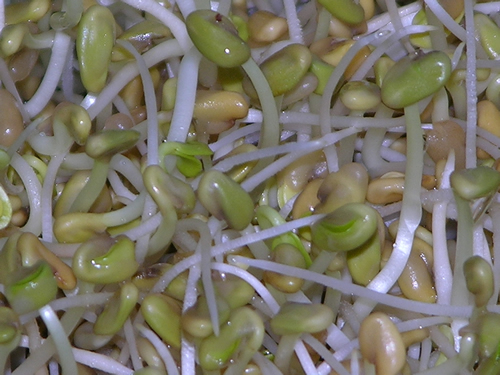Germination: one or two days.
Plant: mid-Spring. Will not do well in the shade. Takes about 16-20 weeks for the plant to mature. At the end of the season, remove aerial parts and leave roots in the ground to fix nitrogen.
Flowers and Seeds: white flowers tinged with violet from mid-summer to autumn. The flowers develop into pods, each containing 10-20 seeds.
Harvest: remove seed pods and dry in sun. Store seeds in airtight container.
Sprout: anytime, ready to eat in 2-3 days
Edible Uses: sprouts, leafy part in salads or exotic dishes, seeds in combination with other spices in cooking. Seeds can be eaten raw, toasted, or cooked.
Taste: "pleasantly" bitter. It is also mucilaginous so the bitterness is buffered somewhat by the gelatinous texture of the fenugreek (which is found in the seeds and sprouts.)

Medicinal Uses: used in Ayurvedic medicine to lower blood sugar and reduce cholesterol. Works by delaying absorption of glucose because of balanced chemical structure. In Western herbal medicine, it has been used to promote breast development, lactation, and libido; reduce PMS and menopausal symptoms; regulate blood sugar; and aid thinking. It is high in antioxidants and is used to retard aging. It is nutritive and used for convalescing patients as well as those suffering from anorexia. It has significant anti-cancer effects and the sprouts are a fabulous lymphatic stimulant and detoxifier. It also tends to resolve kidney stones. It is used in TCM to nourish the kidneys in cases of exhaustion. Many consider it the herb of choice for leaky gut and irritable bowel syndrome because it binds endotoxins.
Constituents: Fenugreek is a natural source of betain and contains all amino acids.
Warnings: Not to be used in excess by pregnant women because of actions on the uterus. However, can be used after childbirth to increase milk production by as much as 900%. Expect perspiration and urine to smell of a sort of curry odor because of a chemical constituent, sotolone.
Commercial Uses: the seeds are sometimes toasted to give a maple syrup like flavor to artificial maple syrups. Makes a yellow dye.
Agricultural Uses: As its Greek name suggests, fenugreek makes a clover substitute for grazing. It is nitrogen fixing.
 Notes: Fenugreek has a long history. It has been carbon-dated to 4000 B.C. in Iraq and was found in the tomb of Tutamkhamen. It has been used medicinally for thousands of years, both internally and externally. It holds a place of prominence in the traditions of North Africa, the Middle East, and India but is also found in European and Chinese medicine. Notes: Fenugreek has a long history. It has been carbon-dated to 4000 B.C. in Iraq and was found in the tomb of Tutamkhamen. It has been used medicinally for thousands of years, both internally and externally. It holds a place of prominence in the traditions of North Africa, the Middle East, and India but is also found in European and Chinese medicine.
|
